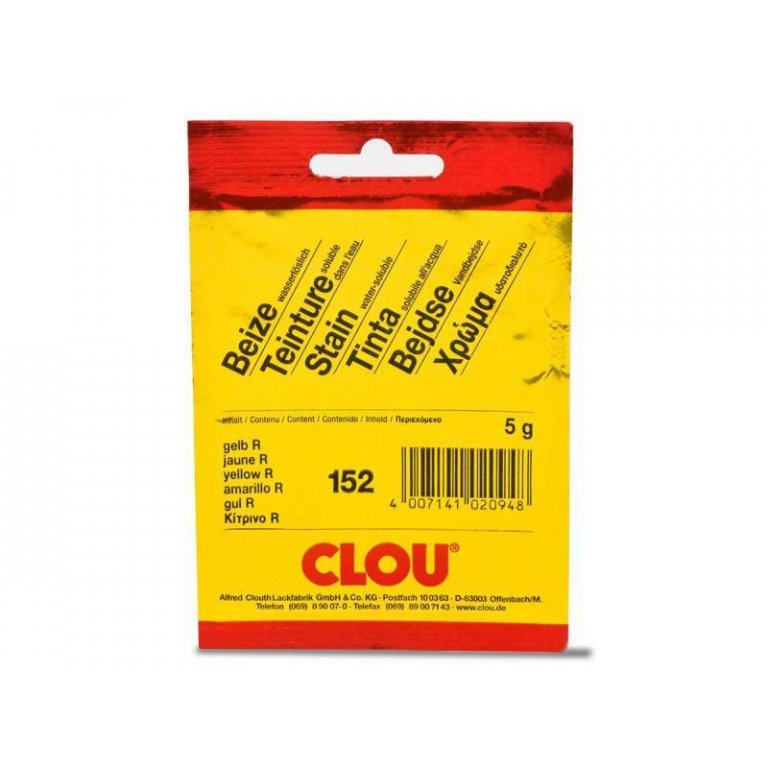| Article No. |
|---|
Clou powder stain is mixed into water and can stain all hard and soft woods (e.g. oak, ash, spruce, limba, beech) in interior spaces.
Processing: For working with liquid stain, you need metal-free brushes and holders to avoid the stain becoming discoloured through oxidation of the metal.
Before applying the stain the wood surface must be wetted so that the wood fibres set up properly. After drying, you should sand the finish with 180 grit sandpaper (e.g. FINISHING PAPER, YELLOW) and carefully remove all dust. It is also important to make a trial run before jumping into the job.
The powder stain should be mixed with hot water (1 bag/250 ml) and, once cooled off, the resulting stain should be applied evenly, one time lengthwise, then crosswise, and finally lengthwise again with a metal-free flat paintbrush (e.g. DA VINCI STAIN BRUSH, FLAT or DA VINCI CORROSIVE ACTION BRUSH, FLAT) or a sponge. After about 1 or 2 minutes any excess stain can be removed with a clean dry brush or sponge.
After being allowed to completely dry over night, the stained surface should be brushed and preferably another coat added (CLOU QUICK SANDING PRIMER B1 and CLOU WOOD LACQUER L1 or CLOU WOOD SEALER). Lacquers that are thinnable with water are not suitable for painting over surfaces that have been stained with water-based stain because they will solvate the the existing stain. Further treatment of a stained wood surface that is not resistant to moisture can not only be done with varnish but also oil or wax.
Tools are best cleaned right away with water.
Free standard delivery within Germany and free collection from Modulor in Berlin for orders over 89 €.
5,95 € shipping costs, if order value is less than 89 € (DE)
2,95 € for pick-up at the store in Berlin, if order value is less than 89 €
Express and forwarding shipping
From 19 € express surcharge you will receive your order particularly quickly with standard shipping within Germany.
From 69€ is the cost of shipping within Germany. You can recognize articles with forwarding shipping in the store by the truck symbol .
Especially for Berlin
From 34.90 € courier shipping for standard and forwarding goods.
- Free returns for standard shipping within Germany
- Extended, voluntary return policy of 30 days for complete, undamaged goods in their original packaging
- You are responsible for the cost of returns for forwarding goods and returns from a country outside Germany
Excluded from returns
Excluded from returns are sections of rolled goods, cut-to-size pieces and other goods made especially for you, as well as used goods, newspapers, magazines and periodicals, Modulor vouchers and items that we do not carry in our range but have ordered at your request.
Good to know: The furniture variants in our configurators that can be delivered quickly are not cut to size, but standard formats that can be returned.
Otto-Scheugenpflug-Straße 2
63073 Offenbach/M
Germany
[email protected]
| Article No. |
|---|
Clou powder stain is mixed into water and can stain all hard and soft woods (e.g. oak, ash, spruce, limba, beech) in interior spaces.
Processing: For working with liquid stain, you need metal-free brushes and holders to avoid the stain becoming discoloured through oxidation of the metal.
Before applying the stain the wood surface must be wetted so that the wood fibres set up properly. After drying, you should sand the finish with 180 grit sandpaper (e.g. FINISHING PAPER, YELLOW) and carefully remove all dust. It is also important to make a trial run before jumping into the job.
The powder stain should be mixed with hot water (1 bag/250 ml) and, once cooled off, the resulting stain should be applied evenly, one time lengthwise, then crosswise, and finally lengthwise again with a metal-free flat paintbrush (e.g. DA VINCI STAIN BRUSH, FLAT or DA VINCI CORROSIVE ACTION BRUSH, FLAT) or a sponge. After about 1 or 2 minutes any excess stain can be removed with a clean dry brush or sponge.
After being allowed to completely dry over night, the stained surface should be brushed and preferably another coat added (CLOU QUICK SANDING PRIMER B1 and CLOU WOOD LACQUER L1 or CLOU WOOD SEALER). Lacquers that are thinnable with water are not suitable for painting over surfaces that have been stained with water-based stain because they will solvate the the existing stain. Further treatment of a stained wood surface that is not resistant to moisture can not only be done with varnish but also oil or wax.
Tools are best cleaned right away with water.
Free standard delivery within Germany and free collection from Modulor in Berlin for orders over 89 €.
5,95 € shipping costs, if order value is less than 89 € (DE)
2,95 € for pick-up at the store in Berlin, if order value is less than 89 €
Express and forwarding shipping
From 19 € express surcharge you will receive your order particularly quickly with standard shipping within Germany.
From 69€ is the cost of shipping within Germany. You can recognize articles with forwarding shipping in the store by the truck symbol .
Especially for Berlin
From 34.90 € courier shipping for standard and forwarding goods.
- Free returns for standard shipping within Germany
- Extended, voluntary return policy of 30 days for complete, undamaged goods in their original packaging
- You are responsible for the cost of returns for forwarding goods and returns from a country outside Germany
Excluded from returns
Excluded from returns are sections of rolled goods, cut-to-size pieces and other goods made especially for you, as well as used goods, newspapers, magazines and periodicals, Modulor vouchers and items that we do not carry in our range but have ordered at your request.
Good to know: The furniture variants in our configurators that can be delivered quickly are not cut to size, but standard formats that can be returned.
Otto-Scheugenpflug-Straße 2
63073 Offenbach/M
Germany
[email protected]
